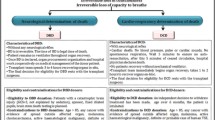Summary
Donation after brain death followed by circulatory death (DBCD) is a unique practice in China. The aim of this study was to define the pathologic characteristics of DBCD liver allografts in a porcine model. Fifteen male pigs (25–30 kg) were allocated randomly into donation after brain death (DBD), donation after circulatory death (DCD) and DBCD groups. Brain death was induced by augmenting intracranial pressure. Circulatory death was induced by withdrawal of life support in DBCD group and by venous injection of 40 mL 10% potassium chloride in DCD group. The donor livers were perfused in situ and kept in cold storage for 4 h. Liver tissue and common bile duct samples were collected for hematoxylin and eosin staining, TUNEL testing and electron microscopic examination. Spot necrosis was found in hepatic parenchyma of DBD and DBCD groups, while a large area of necrosis was shown in DCD group. The apoptosis rate of hepatocytes in DBD [(0.56±0.30)%] and DBCD [(0.50 ± 0.11)%] groups was much lower than that in DCD group [(3.78±0.33)%] (P<0.05). And there was no significant difference between DBD group and DBCD group (P>0.05)). The structures of bile duct were intact in both DBD and DBCD groups, while the biliary epithelium was totally damaged in DCD group. Under electron microscope, the DBD hepatocytes were characterized by intact cell membrane, well-organized endoplasmic reticulum, mild mitochondria edema and abundant glycogens. Broken cell membrane, mild inflammatory cell infiltration and sinusoidal epithelium edema, as well as reduced glycogen volume, were found in the DBCD hepatocytes. The DCD hepatocytes had more profound cell organelle injury and much less glycogen storage. In conclusion, the preservation injury of DBCD liver allografts is much less severe than that of un-controlled DCD, but more severe than that of DBD liver allografts under electron microscope, which might reflect post-transplant liver function to some extent.
Similar content being viewed by others
References
Huang J, Millis JM, Mao Y, et al. A pilot programme of organ donation after cardiac death in China. Lancet, 2012,379(9818):862–865
Huang J, Wang H, Fan ST, et al. The national program for deceased organ donation in China. Transplantation, 2013, 96(1):5–9
Suzuki S, Toledo-Pereyra LH, Rodriguez FJ, et al. Neutrophil infiltration as an important factor in liver ischemia and reperfusion injury. Modulating effects of FK506 and cyclosporine. Transplantation, 1993,55(6):1265–1272
Akoh JA. Kidney donation after cardiac death. World J Nephro, 2012,1(3):79–91
Monbaliu D, Pirenne J, Talbot D. Liver transplantation using Donation after Cardiac Death donors. J Hepatol, 2012,56(2):474–485
Brunner SM, Junger H, Ruemmele P, et al. Bile duct damage after cold storage of deceased donor livers predicts biliary complications after liver transplantation. J Hepatol, 2013,58(6):1133–1139
Author information
Authors and Affiliations
Corresponding authors
Additional information
These authors contributed equally to this work.
This study was supported by grants from the National High Technology Research and Development Program of China (863 Program) (No. 2012AA021008), the Special Fund for Science Research by Ministry of Health (No. 201302009), the Key Clinical Specialty Construction Project of National Health and Family Planning Commission of the People’s Republic of China, the Science and Technology Planning Key Clinical Project of Guangdong Province (No. 2011A030400005), and the Key Laboratory Construction Project of Guangdong Province.
Rights and permissions
About this article
Cite this article
Ye, H., Wang, Dp., Zhang, Cz. et al. Pathological characteristics of liver allografts from donation after brain death followed by cardiac death in pigs. J. Huazhong Univ. Sci. Technol. [Med. Sci.] 34, 687–691 (2014). https://doi.org/10.1007/s11596-014-1337-6
Received:
Revised:
Published:
Issue Date:
DOI: https://doi.org/10.1007/s11596-014-1337-6




